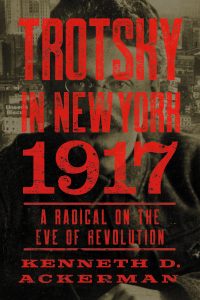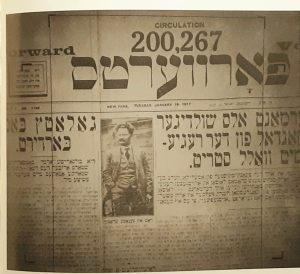Trotsky in New York, 1917: A Radical on the Eve of Revolution
 Trotsky in New York, 1917: A Radical on the Eve of Revolution, by Kenneth D. Ackerman (Berkeley, CA: Counterpoint, 2016)
Trotsky in New York, 1917: A Radical on the Eve of Revolution, by Kenneth D. Ackerman (Berkeley, CA: Counterpoint, 2016)
Leon Trotsky arrived in New York City on January 14 and departed for Russia on March 27, 1917 (where they had started the Revolution without him), so he could take a leading role in overthrowing the Provisional Government. His New York arrival was front-page news in the Forverts and The New York Times headlined its story “Expelled From Four Lands.”
Trotsky was a tireless advocate against the ongoing “imperialist war” and for the international struggle of the working classes against capitalism and the bourgeois state. He did much of his New York writing in the offices of Novy Mir (“New World”), on St. Marks Place, where, according to Kenneth Ackerman, “beat the robust heart of American Bolshevism.” Trotsky worked there with Russian revolutionary emigres including Bukharin and Chudnovsky, to condemn the world war in articles, interviews, as well as through speeches delivered in many venues around town, including Cooper Union, the Lenox Casino, and the Labor Temple near Union Square. He researched American economic history at the New York Public Library.
We also learn about the domestic life of the Trotsky family (his common law wife and two sons had accompanied him on the trip) in a three-room flat on Vyse Avenue near Crotona Park, The Bronx, enjoying electricity, gas cooking, a telephone, bath, and a chute for the garbage, with the Third Avenue El a few blocks away. (Your reviewer visited the site and found that Trotsky’s old tenement home was replaced by a more modern apartment building years later. Unfortunately, there is no historical marker at the site.) His Bronx connection would be reflected in a Bronx Home News headline after the successful Bolshevik takeover in Russia: “Bronx Man Leads Russian Revolution.” 
The book details Trotsky’s ideological clashes with Americans of the left, especially Socialist leader and theoretician Morris Hillquit, who, to Trotsky, was overly concerned with bourgeois legality and would be “the ideal leader for successful dentists”. However, when Trotsky met Eugene Debs at Cooper Union, Debs embraced him and shared Trotsky’s hard line against going to war for any capitalist government, saying “I would…rather be lined up against a wall and shot for treason to Wall Street than to live as a traitor to the working class.” To Trotsky there was no one worse than “the Socialist who defended his country in time of war”. Ackerman’s book offers a useful primer on the schisms wracking the American Socialist movement during this high-water mark for Socialism, just before it would be crushed by our government following U.S. entry into The Great War. Trotsky, who would leave America around two weeks before the declaration of war, was able to fervently criticize President Wilson, the U.S. government, capitalism, and the looming war in the period before the Sedition Act would nullify our First Amendment “for the duration”.
Ackerman’s work may be called popular history, but it presents an even-handed, detailed and exciting view of “Gotham” in the period before we entered The Great War, and of Trotsky’s frenetic activities and relationships during his sojourn here. The dramatic events surrounding his travel to America and return to his homeland add color and suspense to the story. The World Socialist Web Site (wsws.org), known as a Trotskyist source of opinion, issued a favorable view of Trotsky in New York, saying that “it deserves a wide audience” because it is “unaffected by the dishonesty, resentment and hostility typical of most academic biographers of the great revolutionary.”
Reviewed by Keith Danish, who is a member of the Board of the New York Labor History Association and its Book Review Editor.
